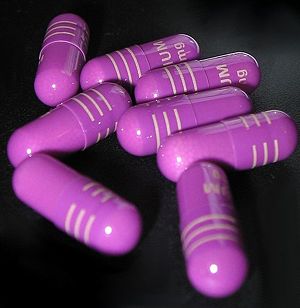User:David Canner/Sandbox 2
From Proteopedia
(Difference between revisions)
(New page: <div name="wrapper" style="height:100%; overflow:hidden; margin:0; padding:0;"> <div id="JmolPane" class="JmolPanels"> <applet load='2cts' size='100%' frame='true' align='right' caption=...) |
|||
| Line 1: | Line 1: | ||
| - | + | [[Image: Nexium.jpg|300px|right|thumb| AstraZeneca’s Nexium]] | |
| + | {{#tree:id=siteTree| | ||
| + | <big>The following is a list of major phamerceutical compound targets, organized by disease. </big> | ||
| - | + | {{TOC limit|limit=2}} | |
| - | + | ==Alzheimer’s Disease== | |
| + | [[Acetylcholinesterase]] <br /> | ||
| + | [[Amyloid Beta]]<br /> | ||
| + | [[Gamma-Secratase]]<br /> | ||
| + | [[Glutamate receptor (GluA2)]]<br /> | ||
| - | + | ==Anemia== | |
| - | + | [[Erythropoietin]]<br /> | |
| - | + | ||
| - | + | ==Asthma and other Pulmonary Disease States== | |
| - | < | + | [[Beta-2-Andrenergic Receptor]]<br /> |
| + | [[Leukotriene Receptor]]<br /> | ||
| - | + | ==Autoimmune Diseases== | |
| - | + | [[Tumor Necrosis Factor Receptor]]<br /> | |
| - | + | ==Blood Clots & Thrombic Events== | |
| + | [[P2Y12]]<br /> | ||
| - | + | **Cancer== | |
| + | ***Growth Factors | ||
| + | ****Epidermal Growth Factor | ||
| + | *****[[Epidermal Growth Factor]] | ||
| + | *****[[Epidermal Growth Factor Receptor]] | ||
| + | ****[[Hepatocyte Growth Factor Receptor]] | ||
| + | ****[[Human Epidermal Growth Factor Receptor 2]] | ||
| + | ****Vascular Growth Factor | ||
| + | *****[[Vascular Endothelial Growth Factor]] | ||
| + | *****[[Vascular Endothelial Growth Factor Receptor]] | ||
| + | ***Kinases | ||
| + | ****[[Cell Division Cycle 7-Related Protein Kinase]] | ||
| + | ****Mitogen-Activated Proteins | ||
| + | *****Mitogen-Activated Protein Kinase | ||
| + | *****Mitogen-Activated Protein Kinase Kinase | ||
| + | *****Mitogen-Activated Protein Kinase Kinase Kinase | ||
| + | ******[[c-Raf]] | ||
| + | ****[[Phosphatidylinositol 3-Kinase]] | ||
| + | ****[[Tyrosine Kinase]] | ||
| + | **[[Heat Shock Protein 90]] | ||
| + | **[[p53]] | ||
| + | **[[Mammalian Target of Rapamycin]] | ||
| + | ==Compromised Immune System== | ||
| + | [[Granulocyte-macrophage colony-stimulating factor]]<br /> | ||
| + | ==Diabetes & Hypoglycemia== | ||
| + | [[Peroxisome Proliferator-Activated Receptors]]<br /> | ||
| + | ==Digestive Diseases== | ||
| + | [[Proton Pump]]<br /> | ||
| - | == | + | ==Erectile Dysfunction== |
| - | + | [[cGMP-Specific Phosphodiesterase Type 5]]<br /> | |
| - | + | ==HIV== | |
| + | [[Reverse Transcriptase]]<br /> | ||
| - | + | ==Hypercholesterolemia (Elevated Cholesterol)== | |
| + | [[HMG-CoA Reductase]]<br /> | ||
| - | + | ==Hypertension & Congestive Heart Failure== | |
| - | </ | + | [[Angiotensin-Converting Enzyme]]<br /> |
| + | [[Calcium Channel]]<br /> | ||
| - | </ | + | ==Inflammation & Rheumatoid Arthritis== |
| + | [[Cyclooxygenase]]<br /> | ||
| + | |||
| + | ==Schizophrenia, Bipolar Depression, Insomnia, and Anxiety Disorders== | ||
| + | [[Dopamine Receptor]]<br /> | ||
| + | [[Andrenergic Receptor]]<br /> | ||
| + | [[Histamine Receptor]]<br /> | ||
| + | [[Opioid Receptor]]<br /> | ||
| + | }} | ||
Revision as of 08:59, 17 September 2010
The following is a list of major phamerceutical compound targets, organized by disease.
Alzheimer’s Disease
Acetylcholinesterase
Amyloid Beta
Gamma-Secratase
Glutamate receptor (GluA2)
Anemia
Asthma and other Pulmonary Disease States
Beta-2-Andrenergic Receptor
Leukotriene Receptor
Autoimmune Diseases
Tumor Necrosis Factor Receptor
Blood Clots & Thrombic Events
Compromised Immune System
Granulocyte-macrophage colony-stimulating factor
Diabetes & Hypoglycemia
Peroxisome Proliferator-Activated Receptors
Digestive Diseases
Erectile Dysfunction
cGMP-Specific Phosphodiesterase Type 5
HIV
Hypercholesterolemia (Elevated Cholesterol)
Hypertension & Congestive Heart Failure
Angiotensin-Converting Enzyme
Calcium Channel
Inflammation & Rheumatoid Arthritis
Schizophrenia, Bipolar Depression, Insomnia, and Anxiety Disorders
Dopamine Receptor
Andrenergic Receptor
Histamine Receptor
Opioid Receptor

